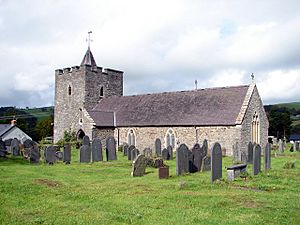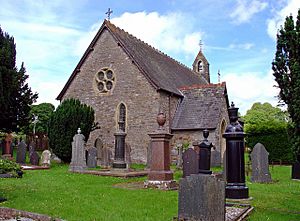Saint Ilar facts for kids
Quick facts for kids Saint Ilar |
|
|---|---|

St Hilary's Church in Llanilar
|
|
| Martyr | |
| Died | 6th century |
| Canonized | Pre-Congregation |
| Feast | 13, 14, or 15 January (lapsed) |
| Patronage | Llanilar Trefilan |
Saint Ilar ([iːlɑr]) was a holy person from the 6th century in Wales. He is listed among the early saints of Wales. He likely gave his name to the village of Llanilar in Ceredigion and a nearby area called Ilar. His special day, or feast day, was celebrated on January 13, 14, or 15. However, this day is no longer officially observed by churches in Wales today.
Who Was Saint Ilar?
Saint Ilar is often confused with another famous saint, Hilary of Poitiers, who also has a feast day on January 13. But the Welsh Saint Ilar is often known by different names to show he was unique. He was sometimes called Ilar Bysgotwr ("Hilary the Fisherman"). He was also known as Ilar Droedwyn ("Hilary Whitefoot") and Ilar Ferthyr ("Hilary the Martyr"). A martyr is someone who dies for their beliefs. Hilary of Poitiers, on the other hand, was a "confessor," meaning he lived a holy life but died peacefully.
There was some confusion in old stories linking Saint Hilary of Poitiers to Wales. Some tales said he helped make Saint Cybi a bishop, even though they lived two centuries apart. Another Saint Hilary, Pope Hilarius from the 5th century, was also said to have helped make Saint Elvis a bishop. Saint Elvis then supposedly baptized Saint David, who is the patron saint of Wales. These stories show how different holy people named Hilary could get mixed up over time.
Saint Ilar's Life
Not much is known about Saint Ilar's life, as he lived a very long time ago. Records suggest he was a companion of other saints, Padarn and Cadfan. They came from Armorica (a region in France) to Wales in the 6th century to spread Christianity. The churches named after Saint Ilar are located near areas linked to Saint Padarn. Because he is called a "martyr," it's thought that Saint Ilar might have been killed during attacks by pagan Irish or Saxon groups at that time. He died defending his faith.
Saint Ilar's Legacy
Today, churches in Wales still honor Saint Ilar. The main church in Llanilar is named after him. Also, the church in Trefilan near Lampeter in Ceredigion is dedicated to Saint Ilar or Hilary. The name Trefilan actually comes from Tref Ilar, which means "Town of Ilar."
Other churches in Wales are also dedicated to "Saint Hilary." These include churches in Erbistock, Killay, and the village of St Hilary. Some historians believe that all these churches might originally have been dedicated to the Welsh Saint Ilar, even if they are now linked to the French Saint Hilary.
A Welsh poet from the 15th century, Lewis Glyn Cothi, wrote about "the festival of generous Ilar." This shows that Saint Ilar was still remembered and celebrated in Wales many centuries after his time.
Saint Ilar, his holy well, and the stories about him being confused with the French bishop Hilary even appear in books. The author Arthur Machen wrote about these legends in his 1907 short story "Levavi Oculos" and his 1922 novel The Secret Glory. These stories tell about a schoolboy's adventures and his connection to the Holy Grail in Welsh and Arthurian legend.
See also
- Saint Eleri, sometimes given as "Saint Ilar"



